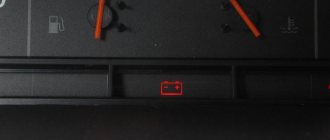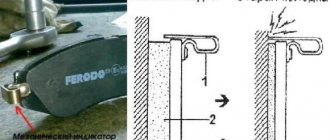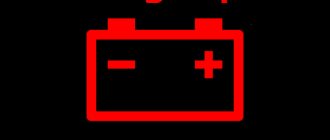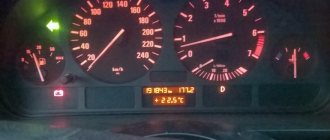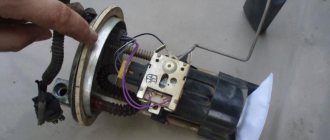Hello everyone, I have this problem: on my way home from work, the charger disappeared, it was raining and there were quite deep puddles. As soon as the “battery light” came on, I immediately stopped and turned it off, looked at the generator - it was dry, the belt was in place and tensioned as it should.
I arrived at the garage and spent a long time fooling around with a book that says: Check fuse F1 under the steering column, but for some reason I don’t have it there at all. In short, I checked all the fuses - everything is fine.
I took off the generator, examined it, but didn’t really notice anything. Guys, tell me why this happened, I’m no stranger to electrics.
If a battery that is more than 5-7 years old is not charging , then the answer to the question is: “ why ?” most likely lies on the surface. After all, any battery has its own service life and over time loses some of its basic performance characteristics. But what if the battery lasted no more than 2 or 3 years, or even less? Where then should we look for reasons why the battery does not want to charge? Moreover, this situation occurs not only when recharging from a generator in a car, but even when it is replenished from a charger. Answers must be sought depending on the situation by performing a series of checks followed by procedures aimed at eliminating the problem.
Most often, you can expect 5 main reasons that manifest themselves in eight different situations:
| Situation | What to do |
| Oxidized terminals | Clean and lubricate with special lubricant |
| Broken/loose alternator belt | Stretch or change |
| The diode bridge has failed | Change one or all diodes |
| Voltage regulator faulty | Replace graphite brushes and the regulator itself |
| Deep discharge | Increase the charging voltage or reverse polarity |
| Incorrect electrolyte density | Check and adjust to the required value |
| Sulfation of plates | Perform a polarity reversal, and then several cycles of full charge/discharge with low current |
| One of the cans is closed | Actions to restore a battery with such a defect are ineffective |
The main reasons why the battery may not charge
To understand in detail all the possible malfunctions due to which the car battery does not charge, first of all, clearly define the situation:
| The battery quickly discharges and dies | or he | does not charge at all (does not accept charge) |
In general, when the battery refuses to charge, the following options are allowed:
- plate sulfation;
- destruction of plates;
- terminal oxidation;
- decrease in electrolyte density;
- short circuit
But you shouldn’t worry so much right away, everything is not always so bad, especially if such a problem arose while driving (indicated by a red battery light). It is necessary to consider special cases in which the car battery does not take charge only from the generator or from the charger as well.
The charging system of a car battery contains a number of external devices, on which the performance of the battery itself and the charging process can also greatly depend. To check all external devices, you will need a multimeter (tester); it will allow you to measure the voltage at the battery terminals under different engine operating modes. You will also have to check the generator. But this is only true when the battery does not want to be charged from the generator. If the battery does not take a charge from the charger, then it is advisable to also have a hydrometer to check the density of the electrolyte.
Principle of operation
The autogenerator voltage regulator is designed to maintain the voltage of the on-board network within the required limits under any operating mode and at different generator speeds, load changes and changes in external temperature. It is also capable of performing additional functions - protecting the generator from overloads and emergency operation, automatically connecting the excitation windings or the generator failure alarm system to the on-board circuit.
The operation of any voltage regulator is based on the same principle and is determined by the following factors:
- Rotor speed.
- The current strength that the generator delivers to the load.
- An indicator of the magnetic flux created by the field winding current.
Higher rotor speeds determine an increase in generator voltage. An increase in current strength on the excitation winding makes the magnetic flux stronger, and at the same time the voltage. Any voltage regulator stabilizes it by changing the excitation current. When the voltage increases or decreases, the regulator decreases or increases the excitation current, regulating the voltage within the required limits.
The relay regulator itself is an electronic circuit with outputs to graphite brushes. It is installed both in the generator body itself next to the brushes, and outside it, and then the brushes are attached to the brush holder.
How do you know if the battery is not charging?
The battery does not charge from the generator . The first signal that the battery is not charging is a lit red battery light! And to make sure of this, you can check the battery voltage. There should be 12.5... 12.7 V at the battery terminals. When the engine is started, the voltage will rise to 13.5... 14.5 V. With consumers turned on and the engine running, the voltmeter readings, as a rule, jump from 13.8 to 14.3V. No changes on the voltmeter display or when the indicator goes beyond 14.6V indicates a generator malfunction.
The indicator light has burned out
Here's how to quickly check whether your car's alternator light is burnt out or not:
- The test lamp clamp is placed on the negative wire of the battery or on ground (any exposed area of the body);
- disconnect the block with the indicator wire from the generator;
Block with indicator wire
- turn on the ignition, touch the plug terminal with the second test probe (where the battery indicator wire goes).
If the light comes on, then it is in order, there is no problem even in the entire area from the generator to the instrument panel. Most likely there is a fault in the block or connection. It is possible that the regulator relay is damaged because it does not produce normal voltage.
If the generator controller does not light up, then the light bulb or fuse has already blown. In this case, auto electricians go through the entire ignition circuit in this area.
What can you do when your car battery is not charging?
The first step is to find out the cause, and only then take action to eliminate it. To do this, you need to measure the voltage at the battery terminals, check the level, density of the electrolyte and its color. It is also, of course, necessary to visually inspect the surface of the battery, the car wiring, and also to determine the current leakage.
Let us consider in detail the possible consequences of each of the reasons for poor battery performance, and also determine what needs to be done in a given situation:
Oxidation of contact terminals
both prevents good contact and contributes to current leakage. As a result, we get a quick discharge or unstable/absent charging from the generator. There is only one way out - check not only the condition of the battery terminals, but also the condition of the generator and the ground of the car. Heavily oxidized terminals can be removed by cleaning and lubricating the oxides.
Generator malfunction
(belt, regulator, diodes).
Belt break
you would probably notice, but the fact is that even a slight loosening of the tension can contribute to slippage on the pulley (as well as oil ingress). Therefore, when powerful consumers are turned on, the light on the panel may light up and the battery will discharge, and on a cold engine a squeaking sound can often be heard from under the hood. This problem can be eliminated either by tensioning or replacement.
Diodes
in normal condition they should pass current only in one direction; checking with a multimeter will make it possible to identify the faulty one, although often they simply change the entire diode bridge. Improperly functioning diodes can cause both undercharging and overcharging of the battery.
When the diodes are normal, but they get very hot during operation, it means the battery is being overcharged. The regulator is responsible for the voltage . It is better to change it immediately. In a situation where the battery is not fully charged, you need to pay attention to the generator brushes (after all, they wear out over time).
During deep discharge
, as well as with a slight shedding of the active mass, when the battery does not want to be charged not only in the car from the generator, but even the charger does not see it, you can reverse the polarity or give a high voltage so that it grabs the charge.
Electric circuit
First of all, the wiring of the connector that sits on the generator is checked. On many modern cars, this cable is brown-white or red and goes to a plug located in the dashboard.
Generator connector
How to diagnose it:
- open the hood;
- remove the connector from the generator;
- short it to ground.
If the battery light does not light up when the ignition is turned on, you need to partially disassemble the car’s dashboard. Here you need to look for the plug where wire number 32 enters. This is the circuit responsible for the operation of the battery indicator. It must be tested with a multimeter to determine integrity. If there is no ringing of this wire, this will indicate a problem - a break. The malfunction usually occurs in the engine compartment. For example, damage to the insulation or complete destruction of the wire in the area of connection with the connector.
The second scenario is when the lamp wire rings. Then you need to completely disassemble the device in order to dismantle and check the microcircuit (the light bulb wire under pin 32 is connected to it, this is a minus).
The plus goes to the 21st leg from the ignition switch, and through the entire console it closes the 32nd leg (when turned on), and then the regulator goes to the relay.
Block with microcircuit
Now about how the microcircuit is checked:
- the adjustable voltage unit is set to 12 volts;
- the outputs of the improvised block are connected to the probes of the tester;
- multimeter probes are applied to legs 21 and 32 simultaneously;
- if the red indicator on the unit lights up, the device is intact, otherwise the burnt-out diodes will need to be replaced.
LED is on
Another problem may be affecting the contacts. This is a fairly common malfunction, usually appearing in the spring. After winter frosts, moisture settles on the plugs/connectors, which provokes oxidation. As a result, the battery charge lamp is unstable or refuses to light up at all. Proper cleaning of the connection and applying grease to the contacts will help here (battery is also implied).
So, we found out that when the battery charging indicator lamp does not light up when the ignition is turned on, there are 4 main methods. Check the battery, fuse (relay), the light bulb itself and the electrical circuit. The situation will be more complicated when the cause is the generator - the voltage is not supplied due to a faulty unit. In this case, you will have to dismantle it and carry out repairs.
Several times I found myself in an unpleasant situation when the prior generator did not charge, and at the most inopportune moment, due to the battery being discharged, I could not start the car.
At the same time, the control light did not light up while driving, but the fact that it did not light up and when I turned on the ignition, I did not pay attention to it. The generator was not charging. When you turn on the ignition, a lot of warning lights come on and it’s very difficult to see that any are off, and you almost never pay attention to them.
The car started, the pressure light went out, and the rest did not affect the speed. Yes, and it’s built into the subconscious if the charge is lost, then the battery sign will light up.
Causes of malfunction of starter car batteries
The service life of a battery discharged by 25% is significantly reduced if:
- malfunction of the generator and voltage regulator;
- starter malfunctions leading to an increase in current or an increase in the number of attempts to start the engine;
- oxidation of power wire terminals;
- constant use of powerful consumers during long periods of idle time in traffic jams;
- repeated cranking of the crankshaft with the starter on short trips.
A reduced electrolyte level during battery operation is also a key reason for rapid battery failure. Therefore, the cause of the malfunction may be:
- Rare electrolyte level monitoring. In summer, checking should be done more often because high temperatures promote rapid evaporation of water;
- Intensive use of the car (when the mileage is more than 60 thousand km per year). Requires checking the electrolyte level at least every 3-4 thousand kilometers.
Diagnostic Tools
The right tools will make it faster and easier to diagnose the problem when you turn on the ignition. Therefore, let’s not be lazy, prepare everything you need:
- portable powerful lamp for good lighting;
- controller with probe and clamp;
- battery load plug;
Checking the battery with a load fork
- cable tracker or locator for locating a wire/cable and tracing the entire circuit in the cable line to the relay - consists of a receiver and transmitter;
- multimeter for checking the lamp;
Multimeter
- improvised adjustable voltage unit, professional or homemade, simple type.
Adjustable voltage unit
Graphic representation of the situation when the battery is not charging. Infographics
To enlarge the image, just click on the picture.
By the way, problems with charging on all those cars that I personally had to use occurred extremely rarely. For the most part, this began after the 90-100 thousand mileage mark. Priora is no exception. If on a relatively new car, when the new generator and all other components are in perfect order, these problems are practically eliminated, then on a used car, problems with battery charging can occur quite often.
Device
Before you look for alternator faults in your VAZ 2110, you need to know that the fundamental design and principle of its operation are the same for all types of cars. They can differ only in dimensions, workmanship and location of mounting fasteners. Therefore, to broaden your horizons, you can listen to the advice of owners of all brands of cars, since some generator spare parts are interchangeable.
The photo highlights the main components of the generator:
- Alternator belt pulley (I hope there is no need to explain its purpose);
- A housing consisting of a front half located on the pulley side and a rear half, which is installed on the slip ring side. In addition, in the rear part of the case there is a brush assembly, a rectifier, a voltage regulator, as well as electrical wiring leads for connecting to the vehicle's electrical circuit.
Why is there no battery charging and where to look for it?
In fact, there are a great many reasons why charging may fail. And most of them are connected with the most important unit in this regard - the generator. Let's look at the main ones that can most often occur.
- Wear of generator brushes on Priora. As mentioned above, when all the parts are still new and without wear, then such malfunctions essentially cannot exist. But when the mark is 90-100 thousand km. has already been overcome, the first calls begin. And the most common reason for the battery not charging is excessive wear of the brushes. This issue can be easily resolved - replace them with new ones. The price of the assembled part is about 350 rubles.
- The second reason can also be compared with brushes, since it is with this part that they come into contact during operation. These are the armature slip rings. It is worth removing the plastic cover of the generator and looking at the contact points of the brushes and rings to understand how much wear these parts have had! It is not always possible to carry out this replacement on your own, but almost any electrician will do it in half an hour.
- Failure of the generator diode bridge. Even if one of the diodes breaks through, there will be poor charging, which will lead to a constant discharge of the battery. In this case, the rectifier unit is replaced.
- Failure of the regulator relay - it is replaced as an assembly with the brush assembly, while the brushes themselves can be replaced separately (again, with the help of a good electrician).
- More serious problems occur with parts such as the stator, rotor, bearings, etc., which are actually much less common than the above cases.
Generator repair kits
To eliminate these generator malfunctions, you will need to carry out repairs. When you start searching for a generator repair kit on the Internet, you should prepare for disappointment - the kits offered usually contain washers, bolts and nuts. And sometimes the generator can only be restored to functionality by replacing brushes, a diode bridge, a regulator... Therefore, the brave person who decides to repair it makes an individual repair kit from those parts that fit his generator. It looks something like this, as shown in the table below, using the example of a pair of generators for a VAZ 2110 and a Ford Focus 2.
| Generator KZATE 9402.3701-03 | ||
| Detail | Catalog number | Price, rub.) |
| Brushes | 1127014022 | 105 |
| Voltage regulator | 844.3702 | 580 |
| Diode bridge | BVO4-105-01 | 500 |
| Bearings | 6303 and 6203 | 345 |
| Generator Bosch 0 986 041 850 | ||
| Detail | Catalog number | Price, rub.) |
| Brushes | 140371 | 30 |
| Brush holder | 235607 | 245 |
| Voltage regulator | IN6601 | 1020 |
| Diode bridge | INR431 | 1400 |
| Bearings | 140084 and 140093 | 140/200 rubles |
Symptoms of loss of battery charging on a Priora
The very first thing that many people pay attention to is that the battery charging light on the dashboard came on. If you have a multimeter at hand, you can measure the output charging current by connecting the contacts to the “+” and “-” terminals, respectively. If even without a load the device readings are less than 13 Volts, this indicates that there are certain problems with charging.
Of course, it is possible (although it is highly not recommended) to remove the “-” terminal from the battery while the engine is running, thereby checking the functionality of the generator. If the engine stalls, this will indicate that there is actually no charging, and accordingly, the generator is faulty.
Also, the charging lamp may glow at half-glow, which also indicates insufficient charging current. If one of the symptoms listed above occurs, it is necessary to diagnose the generator and its parts. If necessary, replace them with new ones. If you have anything to add to this article, you can comment below.
ValeriNazar › Blog › Not excited generator 2110
ValeriNazar last online 1 day ago
Valerii Kliuchnikov, 28 years old I drive Lada 112 Coupe Nazarovo, Russia
The problem of such a car in 2008, europanel. I decided to replace the tidy fresher because My start to do strange things. Found in ads dashboard with fresh Kalina, and the price is sweet, only 1,000 rubles, and the mileage on it 800 km. The owner said that as a car bought with the cabin itself immediately ordered Gamma (tidy), and this put. Well. I take away this tidy myself giving 1,000 rubles. Sticks and what I see I do not charging battery on the panel lights up, I gazanul to 2500, charging gone, the light went out. I put my old no such tidy. What could it be, I want a new tidy and want to charge was?
Powered by Google Translate
Comments 16
Only registered users can participate in discussions.
People, tell me how to solve the problem - when starting the engine, the dashboard lamps light up very dimly (I installed LEDs for brightness), after increasing the speed (reversing the throttle), the lamps light up brightly. I changed the charging regulator, but the problem did not go away. Help with advice!
There may be a diode in the tidy!)) And in the tenth tidy there is a lamp! So think about it)))
That is how it is
